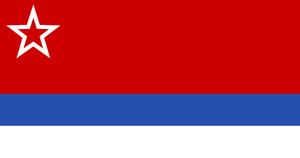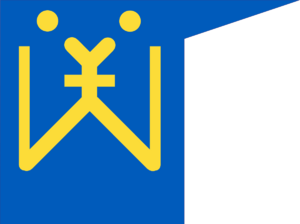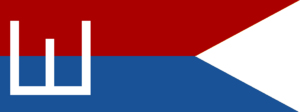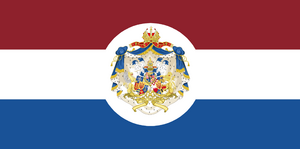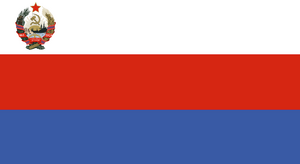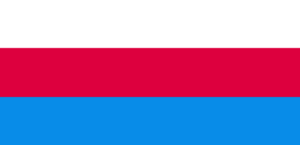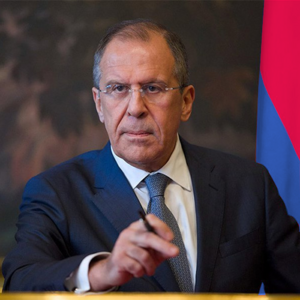Flag of Dulebia
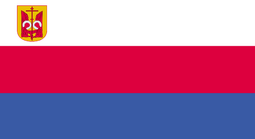 | |
| Name | Государственный флаг / Gosudarstvenny flag |
|---|---|
| Use | State flag and ensign |
| Proportion | 1:2 |
| Adopted | 1990 (introduction) 31 January 2001 (standardisation) |
| Design | A horizontal tricolor of white, red, and blue; charged with the lesser Coat of arms in top left |
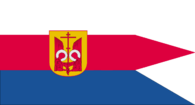 Civil flag | |
| Name | Гражданский флаг / Grazhdansky flag |
| Use | Civil flag and ensign |
| Proportion | 1:2 |
| Adopted | 2001 (current version) |
| Design | Horizontal tricolour of white, red, and blue of swallowtail design, with the coat of arms in the centre |
The flag of Dulebia (Dulebian: Флаг Дулебии, tr. Flag Dulebii), officially The State flag of Republic of Dulebia (Dulebian: Государственный флаг Республики Дулебия, tr. Gosudarstvenny flag Respubliki Dulebiya)) is the official civil and state flag representing Republic of Dulebia. It is a tricolour consisting of three equal horizontal bands, white on the top, red ribbon in the middle, and blue on the bottom. The combination of these three colours was used to symbolise the Dulebian nation ever since the adoption of the first official flag of the Kingdom of Dulebia in 1462. The first tricolour using these colours, however, was adopted in 1721, as the state flag of the Dulebian Empire, however, the colours were placed in different order. The flag gained its current shape after Konev's reformations and the adoption of the second Constitution of People's Republic of Dulebia in 1928. In the top left corner of the flag the national Coat of arms of Dulebia is placed, featuring the two Archangels of Dulebia holding the Dulebian cross and thus forming a trident, the ancient symbol of the Principality of Ulich. The positioning of the Coat of arms copies the position of the State emblem of People's Republic of Dulebia on the state flag of the country used between 1928 and 1990.
The meaning of the colours of the Dulebian flag was standardized in the 2001 Constitution, however, it is strongly disputed if the colours actually beared those meanings in the previous alterations of the flag. White on the flag symbolises the peace and harmony, as well as the freedom of the Dulebian people. The red ribbon is used as the symbol of bravery of the defenders of Dulebia, the blood spilled by Dulebians to protect their sovereignity, and as a reminder of the blood spilled during the revolutions in the 20th century. Blue symbolises the purity of the Dulebian land, the Karsk sea, and is also used as the colour symbolising God in "INSERT RELIGION".
While the three colours of the Dulebian flag predate the Dulebian empire and were first introduced in the Middle ages, both their meaning and positioning was constantly changed together with the form of rule in the country. The tricolour was introduced for first time in the Dulebian empire after the reforms of Peter II, however, in that version the red was on top, while white was in the middle. The tricolour reappeared heavily modified as the first flag of the Dulebian Socialist Federative Republic, where blue and white were once again swapped, red became the dominant colour taking up more than half the height of the flag, and white five-point star appeared in top-left. The flag was once again modified in 1928 when it received its current set-up, with only minor modifications made after the fall of socialism in Dulebia.
Design
The Dulebian national flag is a horizontal tricolour flag, with the Coat of arms of Dulebia placed in the top left corner entirely within the white stripe. The three stripes are equally sized. The flag has a 1:2 ratio. It utilizes 5 colours in total, which are as follows:
| Scheme | White | Red | Blue | Yellow | Blackα |
|---|---|---|---|---|---|
| Pantone | X | 199C | 3590C | 123C | X |
| CMYK | X | 0-100-72-13 | 65-45-0-35 | 4-24-95-0 | X-X-X-100 |
| RGB | 255-255-255 | 221-0-62 | 57-90-165 | 255-199-44 | 0-0-0 |
^α Used as outline in the Coat of arms, but can occassionally be dropped in some versions of the flag.
History
Principality of Ulich
The first recorded flag that was used to represent the Principality of Ulich was a blue banner with golden symbol drawn on it resebling a trident, a symbol that was later representing the city of Ulich. The origin of the banner, as well as the actual symbolism behind it, is unknown. It was found on a Lavarian map made by the merchant Ricardo Avelar, possibly created in 1041. Scientists thus suggest, that the flag was the personal banner of Prince Gavriil II, and that he adopted it as the flag of the Principality once he was throned in 1036. However, no records of the banner have survived until our days, and even the existence of this banner cannot be completely confirmed by scholars. Still, the theory that this flag was used as state flag has a lot of supporters, and it explains why a trident-like symbol later became standardized as royal symbol in the country up until the Dulebian Civil War in eary 20th century.
Kingdom of Dulebia
The first flag of unified Dulebia came into existence in 1462 with the reforms of Tsar Mikhail III, when the first codex of the kingdom was accepted. Tsar Mikhail III initiated a series of reforms that copied the reforms held earlier in neighbouring Lavarian kingdoms. Among the reforms was the introduction of the first standardized banner. According the royal codex, "the banner should be used in time of war, official visits, on official ceremonies and festivals, and should be displayed in the royal palace", for the first time in Dulebian history a flag protocol was created. The flag itself consisted of two stripes, red and blue, and a symbol resembling a trident or fortress tower in the centre of the banner. Drawings of the banner show it both as rectangular and swallowtail, and there are no mentions whether the shape itself was standardized, suggesting that the shape was not a part of the protocol. The banner appeared on numerous Medieval paintings and in several chronicals.
The meaning of the symbol, however, remains a mystery for the experts. In the description of the flag by Mikhail III, the symbol is mentioned only once as "the emblem of the holy City of Ulich", its meaning was not explained, which brings up the conclusion that the symbol was aready used for a long period of time and was associated with Ulich itself. Similar to the flag of the Principality of Ulich, this symbol resembles a trident. In this case, however, historians have also identified several other city emblems and flags throughout Dulebia dating from the same period, all of which featured a similar symbol. In some cases it was further stylized to resemble a guard tower, and the current emblem of the city of Volynsk, which remained unchanged ever since the 13th century, features a tower, which can lead to the conclusion that the symbol at the time was used in Dulebian heraldry to represent castles and towers rather than tridents.
Dulebian Empire
Dulebian Socialist Federative Republic
